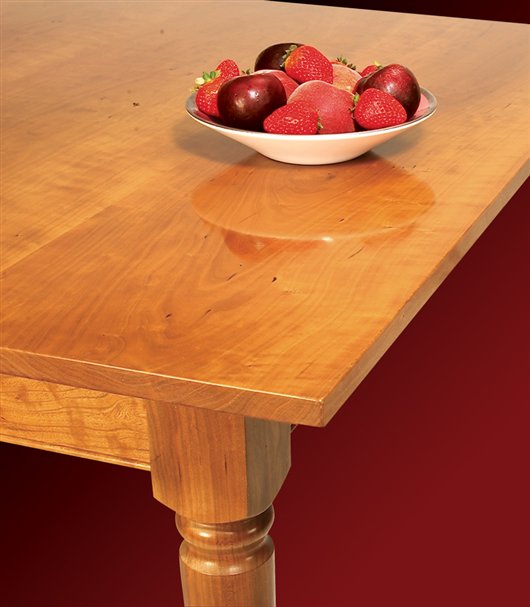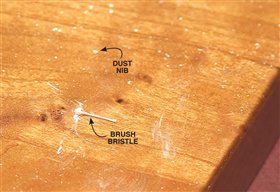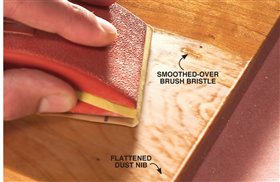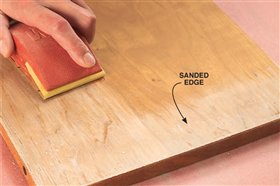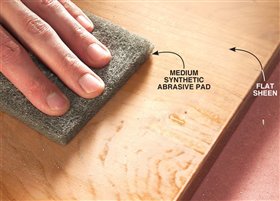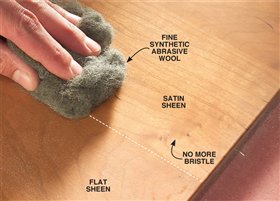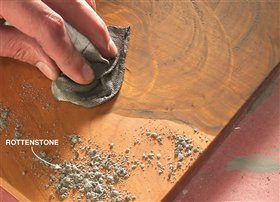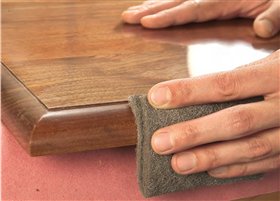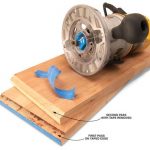Polyurethane is a tough, high-quality finish,
ideal for tabletops and other surfaces
that take a lot of abuse. But no
matter how clean your finishing area or how good your brushing
technique, a few bubbles, dust particles and streaky spots always
manage to sneak into the final coat (Photo 1). Directions on the
can don’t say anything about it—leaving you to assume a less-thanperfect
finish must be your own fault. However, the solution is
quite simple—rub out the finish with fine sandpaper and synthetic
steel wool. Sanding removes defects and levels ridges. Synthetic
steel wool creates an even, silky smooth finish that’s a joy to look
at and feel. This age-old two-step technique is commonly used on
shellac and lacquer finishes, but it can work well on water- and oilbased
polyurethane, too. The only drawback with poly is that it is
difficult to bring up to a high gloss. If a satin or semi-gloss look is
what you’re after, this technique will give you great results.
Materials
and Supplies
Sandpaper
Sandpaper is used to flatten the
finish and remove dust nibs and brush
marks. Stearated aluminum-oxide sandpaper
is by far the best product for sanding a
finish. Stearated paper has dry lubricants that
help prevent “corning” or the balling up of finish
on the paper. Wet-dry silicon-carbide paper balls
up like crazy if you don’t use water as a lubricant.
The trouble with wet sanding is the water slurry can
make it difficult to see your progress.
Synthetic Steel Wool
I used synthetic steel wool on both water- and
oil-based polyurethane. Traditional steel wool is
not recommended for water-based finishes; it sheds
steel particles that leave a mess and give the user
steel wool slivers. Synthetic steel wool pads equivalent
to 00 steel wool are widely available at home
centers and hardware stores. Fine synthetic wool
equivalent to 0000 steel wool is harder to find. I had
good luck at auto-body supply stores and mail-order
woodworking suppliers (see Sources, below).
Powdered Abrasives
Pumice and rottenstone are sold at some paint
stores and at woodworking suppliers. Pumice is
ground volcanic glass that comes in grades from
1F (coarse) to 4F (fine). Rottenstone is even finer
than 4F pumice. It’s made of ground limestone
(see Sources).
Build a Good Foundation
for the Finish
1. I use 220-grit sandpaper for final sanding on raw
wood. I always sand a little bit longer than I think is
necessary. Then I vacuum thoroughly and wipe the
wood with a clean, soft cloth until I stop getting dust
on my fingers when I run them over the wood.
2. Use grain filler on open-pored woods, such as
oak or walnut. Otherwise after rubbing out, the pores
will look shiny compared with the rest of the wood.
3. Before applying finish on any project, test different
finishing options on scrap pieces of wood.
Water- and oil-based polyurethane finishes look
completely different. If the color doesn’t look right
or seems too bland, which is sometimes a problem
with water-based finishes, use a sealer coat of clear,
wax-free shellac or experiment with stains to warm
the color of the wood before applying the topcoats.
4. I applied a gloss polyurethane on my tabletop
because it can be rubbed to any sheen from flat to semi-gloss. I used a semi-gloss poly on the rest of the table.
Vertical surfaces and legs don’t collect the dust the way a
flat, horizontal top does. A light buffing with steel wool
will clean the occasional dust nib on vertical surfaces.
5. Sand with 320- to 400-grit stearated paper
between coats, depending on how smooth the coat
looks. Use a sanding block to level ridges and bumps.
With a gloss finish, coarser paper may leave scratches
that are visible through subsequent layers of poly.
6. Apply an extra coat or two of polyurethane on
tabletops for more durability, depth and protection. Lay
the last coat on a little thick to protect against accidentally
rubbing through the top layer of finish. Remember,
polyurethane does not melt into itself the way shellac or
lacquer do. Each layer sits on top of the previous one, so
there is a danger of sanding through one layer into the
next. This will leave a visible ghost line where the top layer
was sanded through. If this happens, you need to reapply
the last layer of polyurethane and start over.
7. Finish the test boards at the same time you’re
finishing your tabletop. Use these sample pieces to
make sure the finish is properly cured and ready to
rub out. Then experiment on them to get a feel for
rubbing out.
8. Let the finish fully cure! This is most important for a
successful rubout. A finish that has not cured will not be
hard enough to take an even scratch pattern from abrasives.
The result will be an uneven sheen. Polyurethane
should cure for two weeks to a month after the last coat is
applied. If the finish balls up on the sandpaper or it won’t
buff out to more than a satin sheen, let it sit for another
week or two.
Smooth and Flatten
the Finish
It seems completely counterintuitive, but to make a finish
really shine, you have to start by sanding it dull (Photo
2). Sanding removes dust nibs and brush marks and leaves
the finish smooth and flat.
Caution: Finish tends to be thinner at tabletop edges.
Use special care in these areas to avoid sanding through
(Photo 3).
9. Apply consistent, light pressure as you sand. When
you’re done, the surface should feel smooth and level and
will still have a few small shiny spots. Don’t feel that you have to completely erase every visual defect at this point—
just go for a smooth feel. Unless you have lots of bubbles to
flatten, you should only need to sand five to 10 strokes in any
given area with the 600-grit sandpaper. Sand dry so you can
see what’s happening to the finish, and change paper often.
Vacuum all the sanding dust off the surface and wipe with
a damp cloth. Tackcloths can be used on oil-based poly but
not on water-based.
Rub to an Even, Flat Sheen
10. Begin rubbing-out with medium-grade, (00 steel wool
equivalent) synthetic abrasive pads (Photo 4). This is where
the finish begins to come to life, taking on an attractive, flat
sheen with no visible defects.
Rub to a Satin Sheen
11. Clean the top with a damp cloth and continue
buffing with fine synthetic abrasive wool (0000 steel wool
equivalent) (Photo 5). Rub until the whole piece has an
even, satiny sheen, and then rub a little more. There’s not
much danger of rubbing through the finish at this point.
Rub to a Semi-Gloss
12. To bring up the sheen even more, use soapy water or
paraffin oil as a lubricant for the abrasive wool (Photo 6).
Rub thoroughly; then wipe dry.
13. If that’s still not enough shine for you, rub the
entire surface with 4F-grade pumice. After sprinkling
the pumice on the surface, rub it into a paste with
water and a dampened rag (Photo 7). Wipe the slurry
away, and then repeat the process with rottenstone.
Keep firm pressure on the rag, and sprinkle more of
the powder or water as needed. Continue rubbing
in any direction until your arms hurt and the finish
looks satisfactory. Now your furniture has the goodlooking
finish it deserves.
Sources
Note: Product availability and prices are subject to change.
Home centers and hardware stores,
3M packs of two finishing pads, 00 steel wool equivalent;
Sandblaster 400-grit stearated aluminum oxide paper.
Woodworker’s Supply, woodworker.com, 800-645-9292,
Oilfree abrasive wool, fine (000 to 0000 equivalent),
#115-271; medium (1 to 00 equivalent), #115-274; 4F
pumice stone, 1 lb., #849-832; Rottenstone, 1 lb. #849-
839. |
|
Click any image to view a larger version.

1. The Problem: A few dust nibs, broken brush bristles and
bubbles are almost inevitable on big horizontal surfaces finished
with slow-drying polyurethane.

2. The Solution: Flatten the surface imperfections with 600-grit
sandpaper on a sanding block (or 400-grit followed by 600 if the
surface is really a mess). Sand just enough to flatten bubbles, dust
nibs and ridges, but don’t try to sand away all the shiny spots.

3. Extra care should be taken when sanding near the edges
of a tabletop to avoid sanding through. Sand the 2 to 3 in.
nearest the edge first. Short strokes make it easier to control
the block. After the edges are done, sand the centers with long
strokes that overlap the sanded border.

4. Rub out the finish using a medium synthetic abrasive pad
(00 steel wool equivalent). Rub until you get a flat, even
sheen across the entire surface.

5. Switch to a fine synthetic abrasive wool (0000 steel wool
equivalent) to bring the finish to a satin sheen.

6. For a semi-gloss sheen, continue rubbing with fine synthetic
abrasive wool lubricated with soapy water.

7. Using finer and finer abrasives brings the sheen closer to a
full gloss. Start with finest-grade (4F) pumice lubricated with
water and a moist rag, followed by rottenstone. With these finer
grits, it’s OK to use a circular motion as you rub.
Dealing with Molded Edges

Avoid using sandpaper on molded
edges, table legs and other
vertical surfaces. The risk of
cutting through the finish with
the sandpaper is just too great.
Instead, rub molded edges with
synthetic abrasive pads and rub
to the sheen of the top. |



